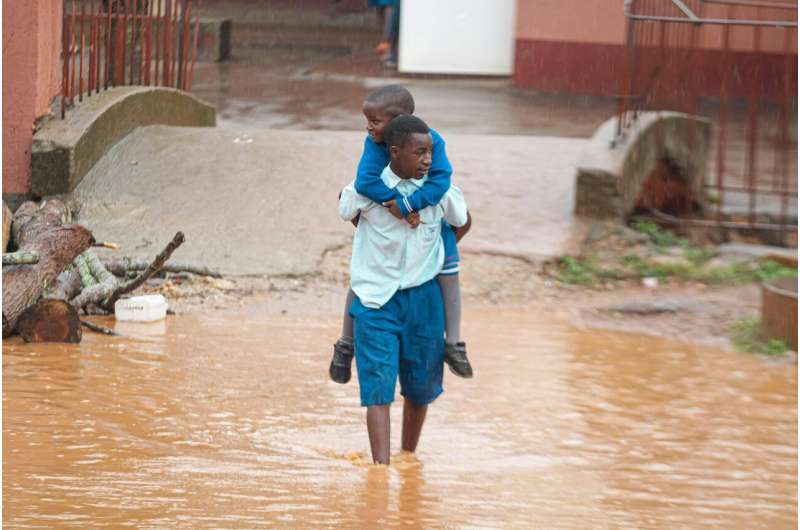Extreme weather changes not only how many people migrate, but who does

Stephanie Baum
scientific editor

Robert Egan
associate editor

When severe heat waves, droughts, and other weather-related disasters strike, age and education shape who migrates and who stays put, according to in Nature Communications.
The study describes how extreme weather can push some groups to move across borders and trap many others in place. These results contrast with mass migration scenarios often invoked in public debates about climate change.
"Weather extremes can both incentivize people to move away and increase the number of people who don't have the ability to migrate," said study author Hélène Benveniste, an assistant professor of environmental social sciences at the Stanford Doerr School of Sustainability. "Our research shows that migration in response to weather, just like migration decisions in general, is highly dependent upon demographic characteristics."
The new analysis helps to resolve contradictory findings from past research. Some earlier studies, for example, have found mixed signals of whether men or women, or people with more or less education, are more likely to migrate following extreme heat.
Together with co-authors Peter Huybers of Harvard University and Jonathan Proctor of the University of British Columbia, Benveniste found that these conflicting outcomes often reflect global patterns shaped by local climate and the demographics of potential migrants.
'Double penalty'
The researchers analyzed more than 125,000 cases of cross-border migration from 168 origin countries to 23 destinations, and over 480,000 within-country moves in 71 nations. Each move was classified by the migrant's age, education level, sex, origin location, and destination, producing 32 different demographic groups. The team then mapped this dataset to daily records of temperature and soil moisture, which are closely tied to food security, livelihoods, and well-being.
By accounting for demographic differences, the new model predicts migration patterns up to 12 times better for cross-border flows and five times better for movement within countries than previous models that assumed everyone responds to weather shocks the same way. Still, weather itself accounts for no more than 1% of historical changes in international migration, the study found, because migration decisions are driven by multiple other factors besides weather.
Following periods of high heat, the analysis shows, children younger than 15 become less likely to migrate to a new country, while adults with little education become likelier to move away—especially those over 45. Cross-border migration rates of adults with education beyond high school, meanwhile, are little affected by weather.
"Our results indicate that many among those most likely to suffer from climate change impacts will not be able to get out of harm's way," the authors write.
This creates a "double penalty," whereby the people with the least resources to adapt in place also lose access to migration as a viable adaptation strategy as the world warms.
Escaping high heat
Baseline climate conditions appear to play a larger role in shaping moves within countries.
"The effects of weather stress on people's decision to relocate within their own country depend more on local climate zones, as well as demographics," Benveniste said.
For example, adults with higher education living in tropical areas become more likely to relocate within their own countries when temperatures rise. The authors found a single day above 102 degrees Fahrenheit in a tropical zone where the baseline temperature is around 86 F correlates with a roughly 0.5% bump in within-country migration rates among people with higher education, but no effect among those with little education beyond grade school.
In areas that are normally dry and hot, the researchers found unusually severe dry spells increase within-country migration, particularly among the least educated.
No evidence for mass border surges
Projecting forward under a scenario where Earth's average temperature rises beyond 2.1 degrees Celsius above pre-industrial levels, the study estimates migration rates by 2100 could rise by about a quarter among older, less educated adults and fall by as much as a third among the youngest and least educated. These demographic-specific swings are much larger than the 1–5% changes seen when looking only at population averages.
To single out the effect of weather and climate, the authors assumed other migration drivers like conflict, politics, and job opportunities remain fixed. This approach is designed to show "how climate stress will change who is able to move and who is left behind, not to predict the number of people that will move in future decades," Benveniste explained.
Actual future migration will depend on a broad array of social, economic, and policy factors—including nascent efforts to help populations thrive in place or improve their ability to move.
"We hope that policymakers use these results as a basis to more squarely address the needs of different demographic groups," Benveniste said. "We need to answer the needs not just of the people who move, but also those who are moving less."
More information: Hélène Benveniste et al, Global climate migration is a story of who and not just how many, Nature Communications (2025).
Journal information: Nature Communications
Provided by Stanford University





















